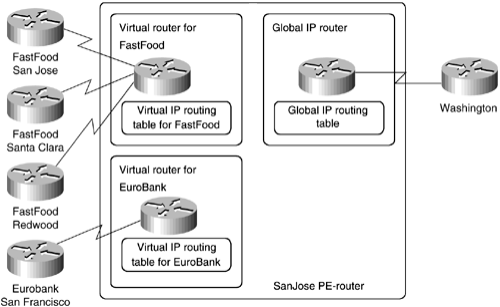CCIE SP MPLS FAQ: MPLS/VPN Architecture Overview
Figure: Virtual Routers Created in a PE Router
Q1. How can overlapping IP addresses be supported between customer sites when MPLS VPN is deployed?
Answer: Each VPN has access to its own routing and forwarding tables
Q2. What routing information is contained within the global routing table on PE routers?
Answer: Routes internal to the P network (internal service provider
Q3. The combination of the per-VPN routing table and per-VPN forwarding table is known as what?
Answer: Virtual Routing and Forwarding Instance (VRF).
Q4. What is a route target?
Answer: A route target is a 64 bit value attached to a BGP route as an
Q5. What is the purpose of the route target?
Answer: To determine which routes must be imported into which VRFs so that VPN membership can be achieved.
Q6. How are client VPN routes distributed across the service provider P network?
Answer: Through use of Multiprotocol BGP (MP-BGP), which provides extensions to BGP so that non-IP prefixes can be transported.
Q7. What is a route distinguisher (RD)?
Answer: The RD is a 64-bit prefix prepended to a VPN client IPv4 address to make it globally unique across the P network.
Q8. What is a routing context?
Answer: It is a routing instance within a routing process that distinguishes between different VPN routing information.
More Resources
